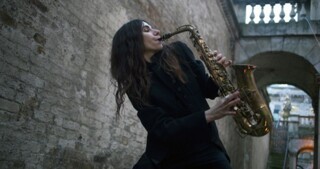PJ through the One-Way Glass
Joanna Biggs
PJ Harvey recorded her eighth album, Let England Shake (2011), in a church on a Dorset clifftop with ‘a graveyard which has trees bent by the wind’. On Saturday, shefinished sessions for her ninth album in the basement of Somerset House on the banks of theThames, whose water had cracked the institutional white paint and seeped mouldily into the carpet. She worked on the songs for a month in a purpose-built white studio with one-way windows, lettingthe public eavesdrop on her (there were four 45-minute visiting sessions each day; tickets sold out fast). I went on the last day.
She let Artangel put windows in her studio hoping that ‘people will see the attention and the labour and the care that goes into making a recording. I hope people will see the interactions betweeneveryone involved.’ I think of Harvey as I saw her at the Reading Festival in 2001, rolling around on stage in bra, miniskirtand boots, sheela-na-gig-unshy to show us her knickers. In the white box studio, which reminded me of the snake house in a zoo, she looked small, thin, with long unkempt hair. She sat still andstraight-backed as she played her riffs with headphones nestled over her hair, and when she spoke (I didn’t get to hear her sing) it was with a small English voice. I could barely recall the howland moan I'd heard at Reading.
I expected the attention to unplugging and in-plugging of leads and the mouth organs being systematically wiped clean with a Boots babywipe but not that the labour and the care would be most oftenvisible in the way everyone – the producers Flood and John Parish, as well as the other musicians – listened. Much of the session was spent on a guitar riff that didn’t seem to be working. The riffwas tried louder and softer, with more or less distortion, until Parish unfolded himself from his cross-legged, chin-tipped listening position and said the guitar was ‘killing the song’. Harveysuggested an organ to replace the guitar, and added a note to the handwritten song chart on the back wall: ‘needs rhythmic musicality’.
We, the unobserved spectators, couldn’t hear what was wrong because we could only hear part of the whole. Like sitting next to someone on the bus singing along to the music in their ears, we couldhear the guitar and fragments of the vocals but not the drums and other instruments that Harvey could hear through her headphones. I’d lost sense of time in this clockless milky-pale basementhearing the same riff over and over again and started to worry that my 45 minutes were up.
Abandoning the guitar led to a frenzy of new ideas, and the new problem of how to describe them. They tried out odd noises: plinky plink zzzzzhh dung-gang dung-gang dung-gang tig-ting tig-tingtig-ting. Apart from the mouth organs, there was Harvey's autoharp, her saxophone, a sweet potato of a maraca, a violin, a beaten-up piano as well as drums and guitars. ‘Just like a minordrone, isn’t it?’ Harvey said of an added keyboard part. ‘It sounds a bit sad, a bit mafiosa,’ someone else said. ‘As long as it’s not skanky,’ Harvey said, ‘you can do anything.’
